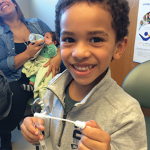WASHINGTON, D.C.—Children in pain—as a result of rheumatic diseases or other causes—is a whole different ballgame than adults in pain in terms of how it’s experienced, how it’s related to others, and the effects of feeling that pain, an expert said at a session titled, “Past, Present and Future Regulatory Perspectives on Analgesics,” at the 2012 ACR/ARHP Annual Meeting, held here November 9–14.
Mark Connelly, PhD, a clinical psychologist and acting director of integrative pain management at Children’s Mercy Hospital in Kansas City, said that, until the 1970s, it was widely believed that young children didn’t experience pain, and it might not be surprising that myths on the subject still persist. For instance, outdated notions persist that children can “get used to” pain more easily or can simply tell adults when they’re in pain.
Communicating Pain
Dr. Connelly said children in pain might communicate their pain in different ways than adults, such as by saying they don’t feel well or by clinging to parents. “If you see pain from an adult lens and apply that lens to pediatrics, you will have outcomes that are misleading,” he said.
The idea that children tolerate discomfort better than adults is not correct, he said—in fact, the reverse seems to be true. “Young children actually are more likely to become sensitized to pain—in other words, experience more pain, in some ways—because they have not yet fully developed the built-in ability to modulate or downregulate the pain as effectively as older kids and adults,” Dr. Connelly said.
Early experiences of pain can have big implications for later in life, he said. “There might be things that happen in early childhood with repeated painful stimulations that ultimately determine which kids might go on to develop chronic widespread pain,” he said.
The overarching idea stemming from pediatric pain research into pain medicine is that, hypothetically, there’s a “normal” pathway from childhood to adulthood when it comes to experiencing pain, and that early experiences might jolt someone off that course. For some children, one bump might be all that it takes; for others, a series of bumps over time might knock them into “an entirely different trajectory into adulthood,” Dr. Connelly said.
Pain from Childhood to Adulthood
There is some indication that pain experienced as a child can lead to chronic widespread pain as an adult. In one Danish study of 650 people, lower back pain in 14-year-old children predicted lower back pain, disability, and hospitalization 25 years later.1
Another study found that multiple common symptoms among seven-year-olds increased the risk of chronic widespread pain when those subjects were 45 years old, although researchers noted that the increased risk was modest and that reports of multiple symptoms in childhood are uncommon.2
Pain can have large effects on the chance of success in life, Dr. Connelly said. Studies have found links between chronic pain and declining grades and missed school time, with many children missing three months or more, he said.3,4
“That is enough to change dramatically their trajectory into adult life,” Dr. Connelly said. “For most kids, that means getting held back a grade. And, if you get held back a grade, your chances of graduating high school are essentially 50-50.”
Ripe for Further Study
Pediatric pain is ripe for further study, but Dr. Connelly said there are important considerations when tackling this kind of research. The tools used to assess pain should be different for kids than for adults, and the developmental levels within pediatrics cross a much wider range than they do in adulthood.
An 18-year-old can be seen as somewhat comparable to other adults, he said. But “within pediatrics, year by year you’re targeting a moving population, with enormous changes in immunological, psychosocial, and neurological development. So there’s a huge developmental range. When you’re enrolling kids in studies, an eight-year-old is very, very different than a 13-year-old.”
Ethical Considerations
In another talk in the session, Joseph Ali, JD, research scientist with the Johns Hopkins Berman Institute of Bioethics in Baltimore, said there are special ethical considerations in studies on pediatric pain, especially nontherapeutic research.
One recent survey of respondents from the United States, Canada, Europe, and Australia looked at 41 studies involving 16 researchers and about 3,000 pediatric participants involved in cold-pressor-task (CPT) studies, in which the arm is placed in a tank of cold water to evaluate pain.5
According to the researchers surveyed, the Institutional Review Board (IRB) “burden” experienced when seeking ethical approval for pediatric nontherapeutic cold-pressor research was comparable to that of other pediatric studies. Just one of the researchers could not get approval from an IRB, and most of the studies underwent full IRB review, with three expedited because they were considered minimal risk. The overall adverse event rate was less than 0.07%.
A majority of the pain researchers (63%) also reported receiving generally positive feedback from families after the children completed the CPT, while 44% reported negative feedback from at least one child, resulting in complaints or withdrawal of data.
In a separate survey related to the same trials, the families and children rated their experience in the CPT study very positively, while children in studies requiring two CPT exposures rated their experiences even more positively.
Ali said that, despite the above findings, federal regulations can be challenging to apply in the world of pediatric pain research. The regulations say that nontherapeutic pediatric research can be approved if there’s minimal risk, defined as the probability and likelihood of possible harm being no greater than that encountered by participants in everyday life. If there’s more risk than that, the prospect for direct benefit is generally needed. But if there’s no direct benefit possible, then there can only be a “minor increase over minimal risk,” and the study has to be likely to yield “generalizable knowledge about subjects’ ‘condition,’ which is of ‘vital’ importance.”
These parameters are open to interpretation, Ali said, and researchers must also be mindful of state laws that may provide additional protections for pediatric research participants. As always, he said, the risk of harms in pediatric research must be weighed against potential benefits, and while the regulations do create important boundaries for pediatric pain research, they are not meant to stand in the way of acceptable forms of research—both therapeutic and nontherapeutic. Ultimately, each study must be evaluated on a case-by-case basis.
“Despite the challenges,” Ali said, “I think, at least at the institutional level, many have managed to evaluate well-designed and justifiable pain research studies fairly and in a way that’s, I think, more understanding [of the patient’s perspective].”
Thomas Collins is a freelance medical journalist based in Florida.
References
- Harreby M, Neergaard K, Hesselsøe G, Kjer J. Are radiologic changes in the thoracic and lumbar spine of adolescents risk factors for low back pain in adults? A 25-year prospective cohort study of 640 school children. Spine. 1995;20:2298-2302.
- Jones GT, Silman AJ, Power C, Macfarlane GJ. Are common symptoms in childhood associated with chronic widespread body pain in adulthood? Results from the 1958 British Birth Cohort Study. Arthritis Rheum. 2007;56:1669-1675.
- Logan DE, Simons LE, Stein MJ, Chastain L. School impairment in adolescents with chronic pain. J Pain. 2008;9:407-416.
- Konijnenberg AY, Uiterwaal CS, Kimpen JL, van der Hoeven J, Buitelaar JK, de Graeff-Meeder ER. Children with unexplained chronic pain: Substantial impairment in everyday life. Arch Dis Child. 2005;90:680-686.
- Birnie KA, Noel M, Chambers CT, von Baeyer CL, Fernandez CV. The cold pressor task: Is it an ethically acceptable pain research method in children? J Pediatr Psychol. 2011;36:1071-1081.

